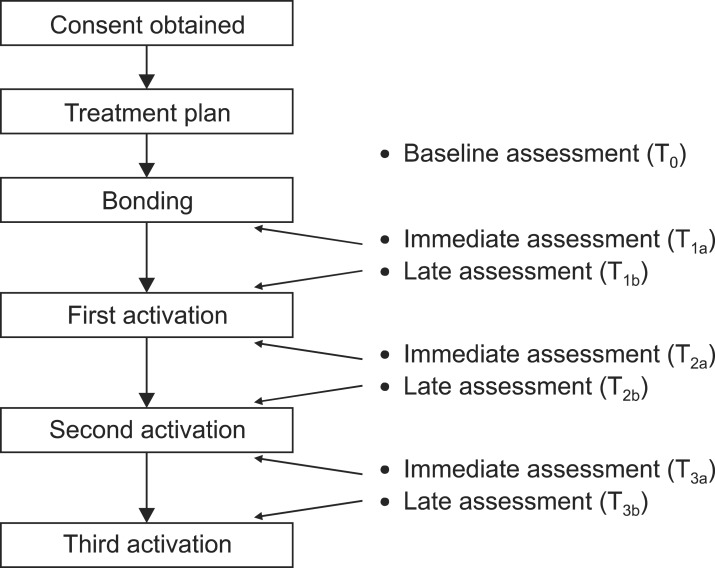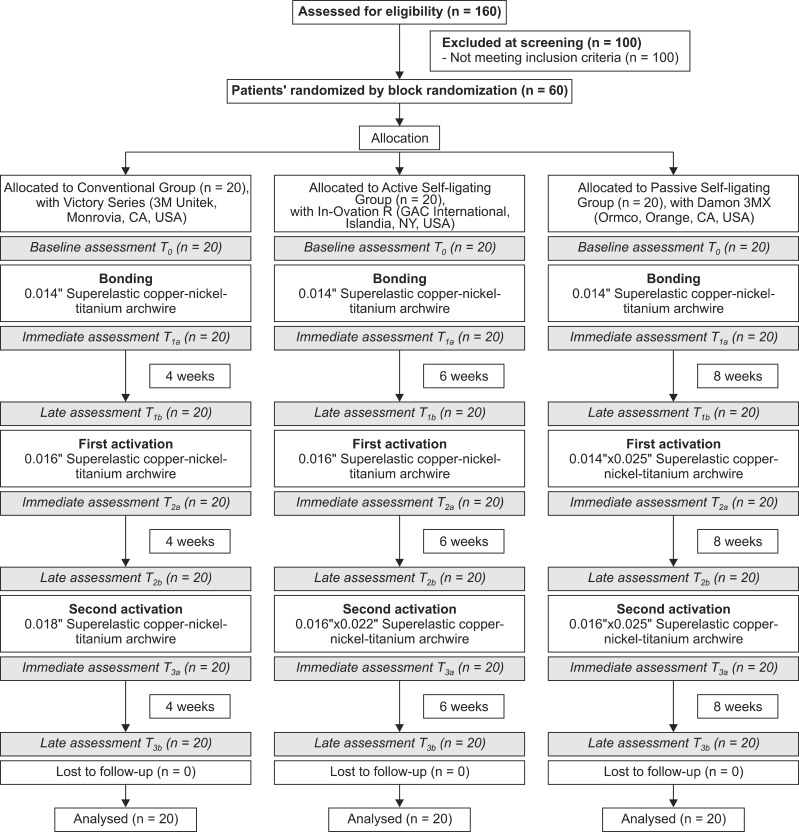Korean J Orthod.
2014 Jul;44(4):168-176. 10.4041/kjod.2014.44.4.168.
Randomized controlled clinical trial of oral health-related quality of life in patients wearing conventional and self-ligating brackets
- Affiliations
-
- 1Department of Paediatric Dentistry and Orthodontics, Faculty of Dentistry, University of Malaya, Kuala Lumpur, Malaysia. sitiadibah@um.edu.my
- 2Clinical Craniofacial Dentistry Research Group, Faculty of Dentistry, University of Malaya, Kuala Lumpur, Malaysia.
- 3Department of Community Oral Health and Clinical Prevention, Faculty of Dentistry, University of Malaya, Kuala Lumpur, Malaysia.
- 4Community Oral Health Research Group, Faculty of Dentistry, University of Malaya, Kuala Lumpur, Malaysia.
- KMID: 2273273
- DOI: http://doi.org/10.4041/kjod.2014.44.4.168
Abstract
OBJECTIVE
The aim of this randomized controlled clinical trial was to compare oral health-related quality of life (OHRQoL) of patients treated with conventional, active self-ligating (ASL), and passive self-ligating (PSL) brackets in different therapeutic phases.
METHODS
Sixty patients (mean age 18.3 years; 29 males and 31 females) requiring orthodontic treatment were randomly and equally assigned to receive conventional (Victory Series), ASL (In-Ovation R), or PSL (Damon 3MX) brackets. OHRQoL was measured with a self-administered modified 16-item Malaysian version of the Oral Health Impact Profile for immediate (soon after the visit) and late (just before the subsequent visit) assessments of the bonding and activation phases. Data were analyzed with the Kruskal-Wallis and chi-square tests.
RESULTS
The PSL and ASL groups showed more immediate and late impacts in the bonding phase, respectively; the conventional group was affected in both the assessments. The first activation phase had similar impacts in the groups. After the second activation, the conventional group showed more immediate impacts, whereas the PSL and ASL groups had more late impacts. The commonly affected domains were "physical disability," "functional limitation," "physical pain," and "psychological discomfort." No significant differences in the prevalence and severity of immediate and late impacts on OHRQoL of the patients were noted in any therapeutic phase.
CONCLUSIONS
No bracket system seems to ensure superior OHRQoL. This information could be useful for explaining the therapeutic phases, especially the initial one, and selecting the optimal bracket system based on the patient's preference.
Figure
Reference
-
1. Cunningham SJ, Hunt NP, Feinmann C. Psychological aspects of orthognathic surgery: a review of the literature. Int J Adult Orthodon Orthognath Surg. 1995; 10:159–172. PMID: 9082004.2. Schmidt A, Ciesielski R, Orthuber W, Koos B. Survey of oral health-related quality of life among skeletal malocclusion patients following orthodontic treatment and orthognathic surgery. J Orofac Orthop. 2013; 74:287–294. PMID: 23807255.
Article3. Bellot-Arcís C, Montiel-Company JM, Almerich-Silla JM. Psychosocial impact of malocclusion in Spanish adolescents. Korean J Orthod. 2013; 43:193–200. PMID: 24015389.
Article4. Cunningham SJ, O'Brien C. Quality of life and orthodontics. Semin Orthod. 2007; 13:96–103.
Article5. O'Brien K, Kay L, Fox D, Mandall N. Assessing oral health outcomes for orthodontics--measuring health status and quality of life. Community Dent Health. 1998; 15:22–26. PMID: 9791611.6. Read-Ward GE, Jones SP, Davies EH. A comparison of self-ligating and conventional orthodontic bracket systems. Br J Orthod. 1997; 24:309–317. PMID: 9459030.
Article7. Harradine NW. Self-ligating brackets and treatment efficiency. Clin Orthod Res. 2001; 4:220–227. PMID: 11683811.
Article8. Khambay B, Millett D, McHugh S. Evaluation of methods of archwire ligation on frictional resistance. Eur J Orthod. 2004; 26:327–332. PMID: 15222719.
Article9. Turnbull NR, Birnie DJ. Treatment efficiency of conventional vs self-ligating brackets: effects of archwire size and material. Am J Orthod Dentofacial Orthop. 2007; 131:395–399. PMID: 17346597.
Article10. Eberting JJ, Straja SR, Tuncay OC. Treatment time, outcome, and patient satisfaction comparisons of Damon and conventional brackets. Clin Orthod Res. 2001; 4:228–234. PMID: 11683812.
Article11. Miles PG. SmartClip versus conventional twin brackets for initial alignment: is there a difference? Aust Orthod J. 2005; 21:123–127. PMID: 16429868.12. Tecco S, DAttilio M, Tetè S, Festa F. Prevalence and type of pain during conventional and self-ligatingorthodontic treatment. Eur J Orthod. 2009; 31:380–384. PMID: 19465738.13. Fleming PS, Dibiase AT, Sarri G, Lee RT. Pain experience during initial alignment with a self-ligating and a conventional fixed orthodontic appliance system. A randomized controlled clinical trial. Angle Orthod. 2009; 79:46–50. PMID: 19123718.14. Fleming PS, Johal A. Self-ligating brackets in orthodontics. A systematic review. Angle Orthod. 2010; 80:575–584. PMID: 20050755.15. Kohli SS, Kohli VS. Patient pain experience after placement of initial aligning archwire using active and passive self-ligating bracket systems: a randomized clinical trial. Orthodontics (Chic.). 2012; 13:e58–e65. PMID: 22567655.16. Liu Z, McGrath C, Hägg U. Associations between orthodontic treatment need and oral health-related quality of life among young adults: does it depend on how you assess them? Community Dent Oral Epidemiol. 2011; 39:137–144. PMID: 21210961.
Article17. Saub R, Locker D, Allison P. Derivation and validation of the short version of the Malaysian Oral Health Impact Profile. Community Dent Oral Epidemiol. 2005; 33:378–383. PMID: 16128798.
Article18. Locker D, Quiñonez C. Functional and psychosocial impacts of oral disorders in Canadian adults: a national population survey. J Can Dent Assoc. 2009; 75:521. PMID: 19744362.19. Fayers PM, Machin D. Quality of Life: assessment, analysis and interpretation. Chichester: John Wiley and Sons Ltd;2000.20. Saub R, Locker D. The impact of oral conditions on the quality of life of the Malaysian adult population: preliminary results. Med J Malaysia. 2006; 61:438–446. PMID: 17243521.21. Major TW, Carey JP, Nobes DS, Major PW. Orthodontic bracket manufacturing tolerances and dimensional differences between select self-ligating brackets. J Dent Biomech. 2010; 2010:781321. PMID: 20981299.22. Krishnan V. Orthodontic pain: from causes to management--a review. Eur J Orthod. 2007; 29:170–179. PMID: 17488999.
Article23. Crawford NL, McCarthy C, Murphy TC, Benson PE. Physical properties of conventional and Super Slick elastomeric ligatures after intraoral use. Angle Orthod. 2010; 80:175–181. PMID: 19852658.
Article24. Ngan P, Kess B, Wilson S. Perception of discomfort by patients undergoing orthodontic treatment. Am J Orthod Dentofacial Orthop. 1989; 96:47–53. PMID: 2750720.
Article25. Jones M, Chan C. The pain and discomfort experienced during orthodontic treatment: a randomized controlled clinical trial of two initial aligning arch wires. Am J Orthod Dentofacial Orthop. 1992; 102:373–381. PMID: 1456222.26. Erdinç AM, Dinçer B. Perception of pain during orthodontic treatment with fixed appliances. Eur J Orthod. 2004; 26:79–85. PMID: 14994886.27. Zhang M, McGrath C, Hägg U. Changes in oral health-related quality of life during fixed orthodontic appliance therapy. Am J Orthod Dentofacial Orthop. 2008; 133:25–29. PMID: 18174067.
Article28. Masood Y, Masood M, Zainul NN, Araby NB, Hussain SF, Newton T. Impact of malocclusion on oral health related quality of life in young people. Health Qual Life Outcomes. 2013; 11:25. PMID: 23443041.
Article29. Rusanen J, Lahti S, Tolvanen M, Pirttiniemi P. Quality of life in patients with severe malocclusion before treatment. Eur J Orthod. 2010; 32:43–48. PMID: 19726489.
Article30. Roscoe JT. Fundamental research statistic for the behavioral sciences. 2nd ed. New York: Holt, Rinehart and Winston;1975.
- Full Text Links
- Actions
-
Cited
- CITED
-
- Close
- Share
- Similar articles
-
- Clinical considerations with self-ligating brackets
- Mandibular changes during initial alignment with SmartClip self-ligating and conventional brackets: A single-center prospective randomized controlled clinical trial
- A comparative study of frictional force in self-ligating brackets according to the bracket-archwire angulation, bracket material, and wire type
- Mandibular arch orthodontic treatment stability using passive self-ligating and conventional systems in adults: A randomized controlled trial
- Effect of different combinations of bracket, archwire and ligature on resistance to sliding and axial rotational control during the first stage of orthodontic treatment: An in-vitro study



